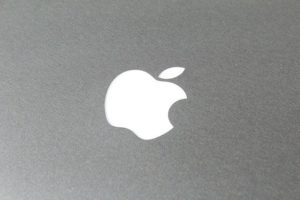An Apple patent for drone telecommunications technology was published last month. Despite the fact that for several years our April Fool’s hoax kept hitting the top stories list, there is still no such thing as an Apple iDrone: but Apple could be looking for an opportunity to enter the drone industry.
By DRONELIFE Staff Writer Jim Magill
Tech giant Apple might be looking to dip its toes into the waters of the unmanned aerial systems business, by offering advanced telecommunications systems for drones.
On the last day of 2020, the U.S. Patent & Trademark Office published an Apple patent application entitled “UE Modem for Drones with Flight Path and 3D Wireless Environment Signal Quality Information.”
The application, which the company filed in June of 2019, seeks to patent “an apparatus of a drone, the apparatus comprising: sensors arranged to determine a geographic location and an orientation of the drone; a plurality of antennas configured to form a beam through which the drone communicates data and control signals with a serving cell using a carrier frequency; an application processor; and a wireless modem arranged to communicate with the serving cell through the antenna and with the application processor.”
Although Apple has yet to comment, drone technology experts said the application could signify that Apple is developing technology to improve drone telecommunications to help usher in a new era of drones equipped with Detect and Avoid (DAA) technology, allowing drone operators to be able to fly beyond the visual line of sight (BVLOS).
“This system is about a lot more than just RID (remote identification),” said Dr. Terry Martin, chief technology officer, Australia-based Skyy Network. “It will improve the quality of the channel for transferring control, telemetry and payload data.”
Martin said that in locations where both 4G and 5G connectivity are available, the proposed Apple technology would “support BVLOS flight with improved confidence that the UAV can be both surveilled and controlled, because the quality of the connection for relaying that information is improved.”
He said this is in contrast to telecommunications using broadcast RID technology, which is limited to the range of WIFI or Bluetooth.
Kenji Sugahara CEO, and founder of Oregon-based UAS research, and development company AriAscend, said the proposed Apple technology represents a new network optimization method for drones in flight. Sugahara, who was recently awarded a patent for broadcast remote identification of drones and is an active member of ASTM working on international industry standards for remote ID, indicated that the technology Apple is seeking to patent could advance drone telecommunication capabilities far beyond just remote ID.
“It’ll help with connection to a network for a variety of purposes including networked (vehicle-to-vehicle) communication, UAS monitoring from ground control, etc.,” he said.
“RID was never designed to deal with DAA,” Sugahara said. “We were very clear with that from the beginning in ASTM. We specifically included a provision in the terms of reference saying that we would add elements that could be helpful to DAA if they did not cause issues with the rest of the standard.”
Dawn Zoldi, CEO and Founder of P3 Tech Consulting, agreed that Apple might be trying to develop the next generation of drone telecommunications technology.
“While the newly released final RID rule is a broadcast-only solution, the FAA left the door open for future network-based systems and RID USS (UAS service suppliers)-like networks,” she said.
The Apple patent application could represent “a strong network solution relevant to enabling not just RID, but also BVLOS flight and UTM (unmanned traffic management).” Zoldi said.
“Apple may just have taken a big bite of the network commercial drone apple.”
However, Roger Fulghum, a Houston-based patent attorney with 26 years of experience, cautioned that the Apple patent application does not necessarily mean that the high-tech company is preparing to enter the drone telecommunications business just yet.
“A company like Apple – and I do not represent Apple — will file hundreds, if not thousands, of patent applications each year. These will cover not only products in development, but they’ll also cover blue-sky ideas where people are thinking about new technologies that are not developed,” he said.
“Not every patent idea will result in a commercial product,” he said.
Miriam McNabb is the Editor-in-Chief of DRONELIFE and CEO of JobForDrones, a professional drone services marketplace, and a fascinated observer of the emerging drone industry and the regulatory environment for drones. Miriam has penned over 3,000 articles focused on the commercial drone space and is an international speaker and recognized figure in the industry. Miriam has a degree from the University of Chicago and over 20 years of experience in high tech sales and marketing for new technologies.
For drone industry consulting or writing, Email Miriam.
TWITTER:@spaldingbarker
Subscribe to DroneLife here.
https://dronelife.com/2021/01/11/apple-patent-for-drone-communications-technology-is-apple-getting-into-the-industry/
 Unmanned Aerial Vehicle The latest drone news
Unmanned Aerial Vehicle The latest drone news




